In the vast tapestry of human history, there are moments when archaeology transcends science and becomes something profoundly human. One such moment emerged at the Lajia archaeological site in Qinghai Province, China, where a discovery moved the world not because of gold, weapons, or palaces, but because of a simple, universal gesture: a mother holding her child.
Locked together in a final embrace for over 4,000 years, this mother and child remind us that love is the most enduring force of all. Their story, unearthed from the ruins of an ancient disaster, has become one of the most touching archaeological finds of modern times.
The Discovery at China’s “Pompeii of the East”
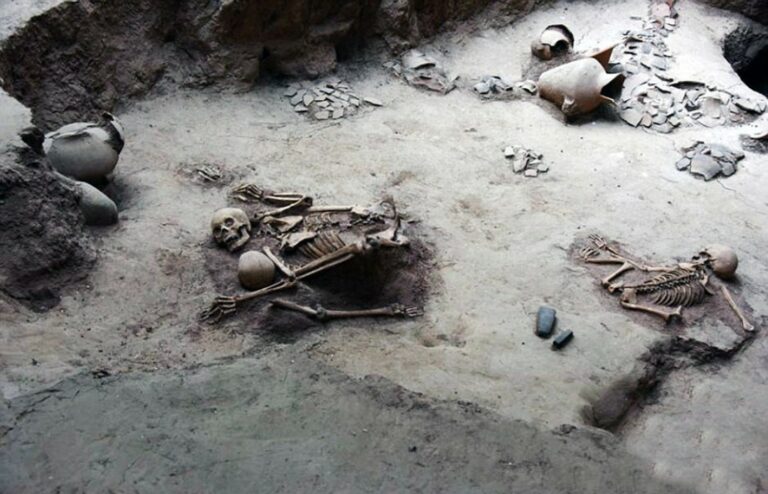
In the early 2000s, archaeologists working at Lajia uncovered a Bronze Age settlement buried beneath layers of earth. The site, which dates back to around 2,000 BC, quickly gained the nickname “the Pompeii of the East” because it appeared to have been destroyed suddenly by natural disaster, preserving an entire community in the midst of their daily lives.
Among pottery, tools, and architectural remains, researchers encountered something far more extraordinary: the skeletons of a woman and child. What startled the team was not just their preservation, but their posture. The mother’s arms were wrapped tightly around her child, her body forming a protective cocoon. Even in the face of catastrophe, her instinct was to shield her little one.
This moment, captured in stone and soil for four millennia, told a story no textbook could—one of love, fear, protection, and humanity’s deepest bonds.
A Moment Frozen in Time
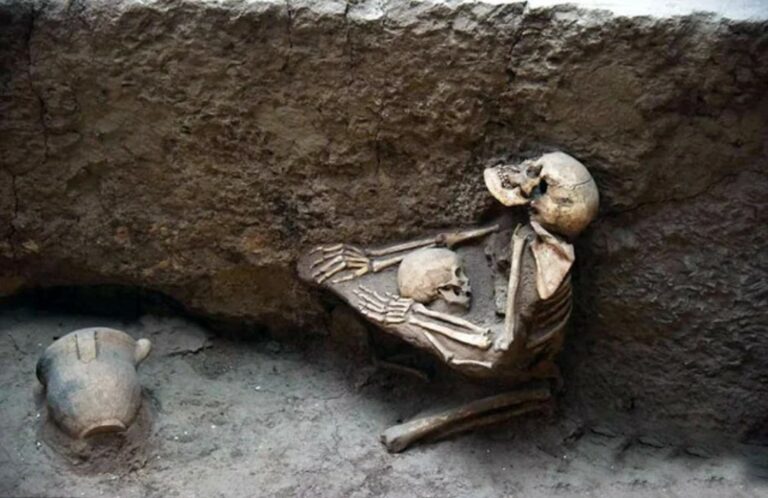
Archaeologists believe that a sudden earthquake, possibly followed by catastrophic flooding from the Yellow River, destroyed the settlement. Families were caught off guard, and many perished instantly. But within the chaos, the scene of the mother and child was preserved like a photograph carved in earth.
The mother, kneeling forward, had drawn the child close to her chest, her head bent protectively. The child’s tiny form pressed against her, a gesture that spoke louder than words across thousands of years.
It is rare in archaeology to find such emotionally powerful scenes. Most remains tell us about diets, diseases, or migration. But here, the posture itself revealed a story—one of instinctive love in the face of disaster.
The Lajia Site: A Window Into the Bronze Age
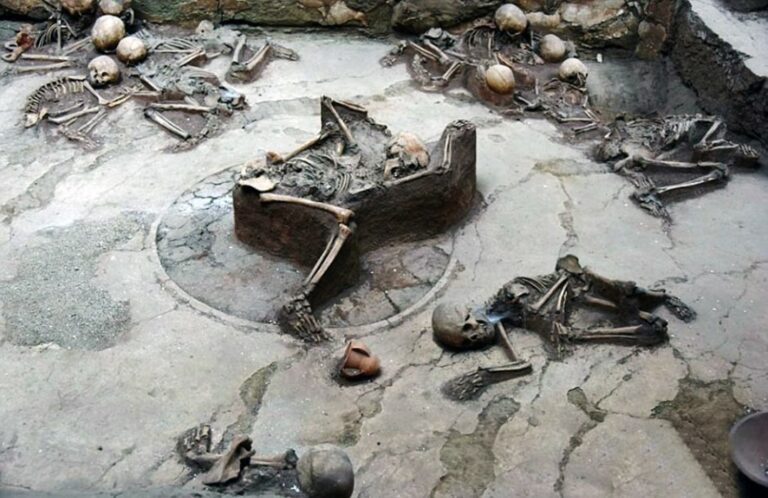
Spanning more than 40,000 square feet, the Lajia site has become China’s largest and most important excavation of its kind. Its discovery has opened an unprecedented window into the Qijia culture, one of the earliest Bronze Age civilizations in the Yellow River valley.
The site includes evidence of homes, workshops, and food storage, as well as everyday objects such as pottery, cooking utensils, and farming tools. These artifacts help researchers reconstruct how people lived: their diets centered on millet, their farming techniques, their pottery styles, and their burial practices.
The sudden destruction of the settlement preserved these details with incredible clarity, much like Pompeii did for ancient Rome. And yet, amid the wealth of data about Bronze Age technology and lifestyle, it is the mother and child that remain the most unforgettable image.
Science Meets Emotion: Understanding the Embrace
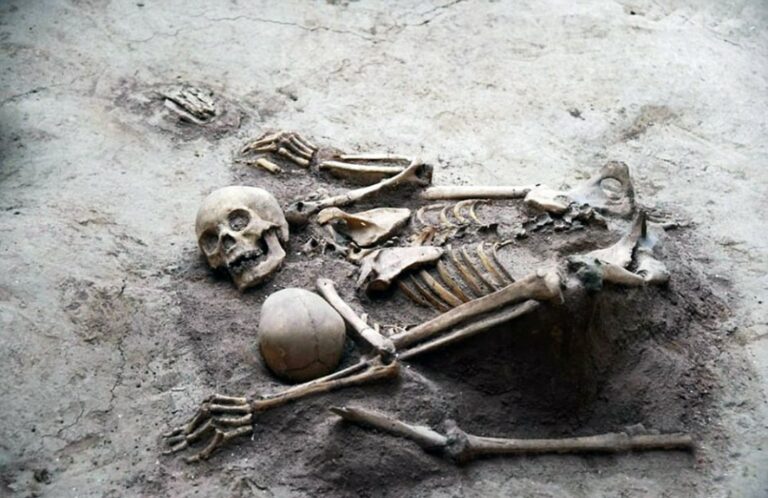
From a scientific perspective, the embrace offers insight into how people reacted to sudden catastrophe. Instead of fleeing or scattering, some families instinctively clung together, seeking protection in their bonds. The mother’s actions remind us that while technologies and civilizations may evolve, the core instincts of humanity remain unchanged.
From an emotional perspective, the embrace resonates across cultures and generations. Parents today, thousands of years later, can immediately understand that gesture. It does not require translation, nor does it lose meaning with time. It is as powerful now as it was in that tragic moment 4,000 years ago.
Parallels With Pompeii
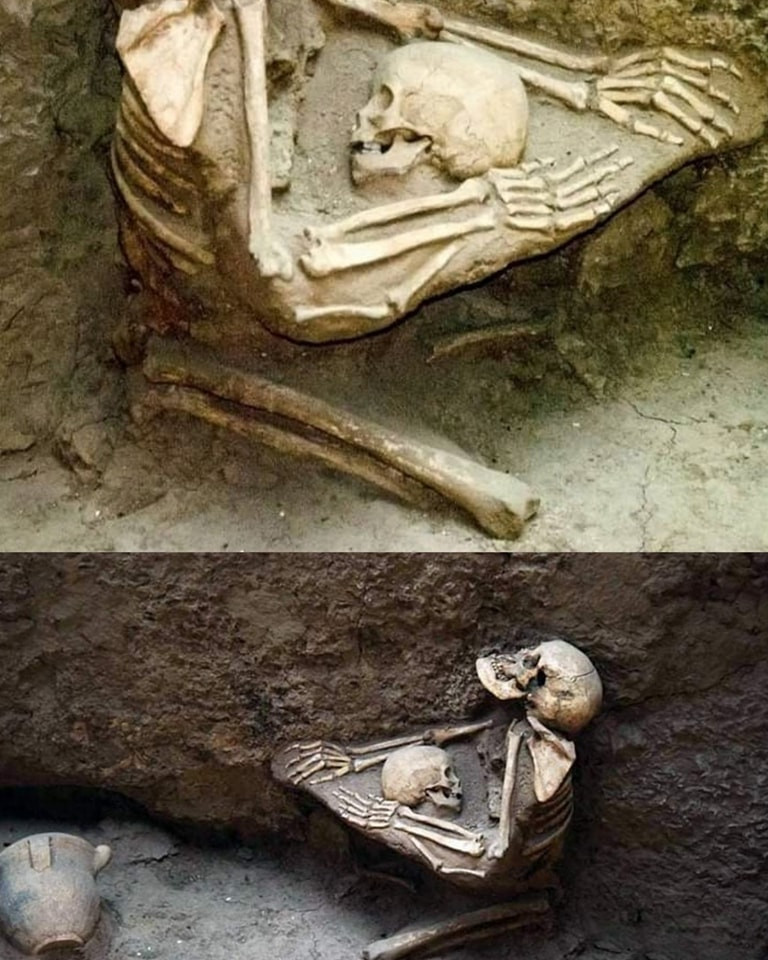
The comparison with Pompeii is more than superficial. In both cases, sudden natural disaster froze people in their final moments. At Pompeii, the eruption of Mount Vesuvius immortalized Romans as they fled, hid, or comforted one another. At Lajia, seismic activity preserved Bronze Age families in their homes.
But where Pompeii gives us a picture of an entire bustling city, Lajia gives us something more intimate—a family’s private moment of love in the face of destruction. While Pompeii’s plaster casts show fear and flight, Lajia’s embrace shows tenderness and care.
A Legacy of Love and Resilience

The embrace is more than an archaeological finding—it is a timeless message. It tells us that, even in the harshest of times, love is the instinct that prevails. The mother could not stop the earthquake, nor shield her child from disaster, but her final act was to hold, protect, and comfort.
This resonates deeply in a modern world where technology changes at dizzying speed. While tools, cities, and empires rise and fall, the human heart remains constant. Across four millennia, the gesture of a mother’s embrace is instantly recognizable, unchanged, and eternal.
Universal Symbolism
The story of the Lajia mother and child has been shared worldwide, touching audiences far beyond archaeology. To some, it is a symbol of parental love. To others, it represents humanity’s fragility in the face of nature. To many, it is a reminder of what truly matters: family, care, and connection.
This discovery has also sparked conversations about how we remember the past. Archaeology often emphasizes kings, wars, and monuments. Yet here, the most powerful story comes from ordinary people—those whose names we do not know, but whose actions reveal the universal truths of the human experience.
Lessons for Today
In times of crisis—whether natural disasters, wars, or personal struggles—people often look for hope and meaning. The embrace from Lajia reminds us that our most meaningful actions are not about power or possessions but about care and compassion.
Parents today continue to sacrifice and protect their children in countless ways, echoing the instincts of the Lajia mother. Her story reassures us that love has always been humanity’s greatest strength, and it will continue to guide us into the future.
Preserving the Site for Future Generations
Because of its significance, the Lajia site has become a key focus for cultural preservation in China. Researchers continue to excavate carefully, using advanced technology such as 3D scanning and ground-penetrating radar to understand the settlement without disturbing its fragile remains.
Efforts are also being made to share the discovery with the public, through museums, exhibitions, and digital reconstructions. By doing so, archaeologists ensure that the story of the Lajia mother and child remains alive—not only as a scientific record but as a human legacy.
Conclusion: A Testament That Transcends Time
The embrace of a mother and child at Lajia is not just a snapshot of the past—it is a mirror of our present and a promise for the future. It tells us that in the face of disaster, in the face of time itself, love endures.
Four thousand years have passed since that moment of protection, but the story still speaks to us today with clarity and warmth. It reminds us that beyond dynasties, beyond monuments, and beyond technology, it is love—the simplest, most powerful force—that defines humanity.
The mother and child of Lajia did not leave behind names or words, yet their embrace tells a story stronger than any written record. It is a universal testament to resilience, sacrifice, and affection—a message carved not in stone but in the shared heart of humanity.
